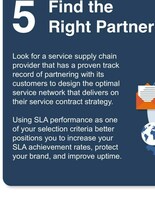A service contract, and its service level agreement (SLA), between an original equipment manufacturer (OEM) and its customer is a promise. A promise of post-sales support for the OEM's product. A mutually agreed upon framework to ensure that should the customer experience unexpected downtime, a part and/or technician will address it with a fix or a replacement per the agreed timeframe in the SLA (i.e., 4-hour, next business day).
Too often, though, OEMs fail to meet their customer SLAs. Not because of parts shortages or supply chain disruptions. Rather, because the SLAs within the service contract are not adequately tuned to reflect the realities of the OEM customer's business.
Often, the OEM is blamed for these "failures" – with consequences that range from temporary customer dissatisfaction to, in worst cases, loss of business and reputational damage.
How do you solve the issue of inconsistent SLA performance? Simple. Write service contracts that contain more effective and appropriate SLAs.
Here are 5 easy ways to do just that. And reap the benefits of the result.
#1 Design Service Contracts with "Optionality"
Each service contract should be designed to allow your customer the ability to choose (and pay) for their SLA options based on their specific outage or maintenance situation. It goes without saying that not every outage or every client in your portfolio requires identical delivery timelines. Sometimes, an equipment failure can be addressed on a best-efforts basis because your customer has redundancy built into their architecture for that specific piece of hardware. In other cases, the equipment in question is a single, critical device so that outage needs the fastest response time possible.
Over-servicing your customers can be costly and set ongoing unrealistic expectations. Therefore, giving clients an array of SLA options within their service contracts, tailored to specific outage situations and their immediate remedy needs, not only can save you money but give you the ability to manage your inventory to maximize the success of your service contract performance.
Furthermore, and this is critical, these option-based SLAs in your service contracts should be achievable on a consistent basis, accounting for the product, region, nearest distribution center with requisite stock, delivery window, penalty for delay and any other mutually agreed upon parameters.
#2. Insist on Real-time Visibility
OEMs can lose up to 30% of their ROI on inventory because of parts sitting idle, aging out, or getting "lost" in the warehouse. Poor visibility and data inaccuracies are the root cause of this ROI drain. They also are prime causes of service support failures.
The solution: Adopt systems and processes that enable 'in-the-moment' inventory visibility across your entire service supply chain. Real-time visibility is critical to meeting your customer SLAs. Without it, your SLA performance is likely to be sub-par.
In-the-moment inventory visibility also enables you to optimize your total inventory investment – thereby avoiding obsolescence, or over- or under-stock situations. For example, having access to real-time inventory movements and consumption allows for daily or weekly trend analysis to monitor demand patterns against transportation spend. This comparison can help identify where you may be overspending on delivery due to lack of inventory availability. There is nothing more costly than having to consistently ship inventory coast to coast or pay for costly next-flight-out air transport due to a lack of inventory visibility and predictive intelligence.
Visibility has a direct effect on your brand, your customers' satisfaction and, ultimately, on your bottom line. It is a must.
#3 Set Clear Disposition Directives
A well-thought-out and efficient returns management authorization (RMA) process is an essential component of your SLAs – and foundational to your bottom line. Quickly and efficiently recovering assets from dark sites or at a customer's data center or location allows you to assess their condition or health and decide on proper disposition.
In contrast, coordinating and transporting supposed defective products to a repair center, finding out after inspection that there was 'no fault found', and needlessly absorbing the costs of transportation, time and effort is very expensive.
Partnering with a company that can offer advanced replacement of your material alongside defective returns management, asset recovery, onsite assessment, repair loop management and dispositioning services saves money, and reduces the time it takes to get your assets back into your service parts network supporting your service contracts.
#4 Know your Lifecycles
Fully understanding the lifecycle of your equipment and service parts is foundational to effectively structuring your service contracts and their SLAs. Armed with parts obsolescence and lifecycle data, you can develop a proactive service parts supply chain.
This means being able to use data to inform and design a service supply chain accordingly – predicting demand and ensuring that the appropriate parts are at the right location, ready for use when needed. No more guessing. Guessing can result in stock outages, delivery delays and other failures that jeopardize your SLAs.
Fully understanding equipment and parts' lifecycles results in better service to your customers, reduced inventories, controlled costs, and greater ROI. For your customers, it translates into increased asset uptime. All of which helps you cement your customer relationships – and boost profitability for both you and your customer.
#5 Find the Right Partner
Outsourcing any element of a business can be daunting. OEMs must trust the partners they choose, as they will be representing the OEM's brand.
Outsourcing the service supply chain is no different. Look for a service supply chain partner that has a proven track record of partnering with its customers to design the optimal service network that delivers on their service contract strategy. Therefore, thoroughly vetting a service supply chain provider, and how its performance in delivering on its customers' SLAs is essential. Using SLA performance as one of your selection criteria is smart business.
A Bottom-Line Benefit
OEMs promise their customers, within their service contract SLAs, various post-sales support, and services. By adopting these five practices to improve performance in meeting SLAs, OEMs are better positioned to increase their SLA achievement rates, protect their brand, bolster customer satisfaction and retention, eliminate costly inventory waste, and improve the bottom line.
About Flash Global
Headquartered in New Jersey, Flash Global designs and implements end-to-end service supply chain strategies for rapidly expanding companies, including many of the world's top high-tech companies. Flash creates global solutions that are locally fueled, enabling companies to efficiently scale in countries worldwide. Companies leverage in-region and in-country expertise throughout Flash's worldwide infrastructure of distribution centers, a global customer response center, and forward stocking locations to seamlessly move products across international borders and serve their customer base.
At Flash Global:
Kelly Gray
Marketing & Communications Lead
[email protected]
SOURCE Flash Global







Share this article